Picture kabocha so sweet it needs no sugar, blended so smooth your spoon glides through like silk.
This potage surpasses both miso soup‘s simplicity and corn potage‘s creaminess. Your family won’t believe you made this at home.

Kabocha Squash Soup
Recipe Snapshot
- What is it? Silky Japanese-style pumpkin potage with herby croutons.
- Flavor profile: Silky, Sweet, Umami-rich
- Why you’ll love this recipe: It’s wholesome, cozy, and beautifully fragrant. A recipe that makes even weeknights feel special.
- Must-haves: Blender (or immersion blender), Kabocha squash, Fine-mesh strainer
- Skill Level: Easy
- Suitable for Meal Prep? Yes!
Summarize & Save this content on:

What is Kabocha Squash Soup?
Kabocha soup (かぼちゃスープ), or kabocha squash potage, is one of those quiet cultural crossovers that feels both French and Japanese at once. The word “potage” came from French cuisine, but in Japan, it evolved into a category of silky soups thickened with pureed vegetables.
Kabocha squash reached Japan through Portuguese traders via Cambodia in the 1500s, and the Japanese word kabocha actually comes from “Cambodia.” Over time, Japan embraced this humble vegetable in dishes like simmered kabocha and kabocha croquette, and eventually turned it into a creamy Western-inspired soup enjoyed in homes and cafés alike.
Kabocha Soup Ingredients
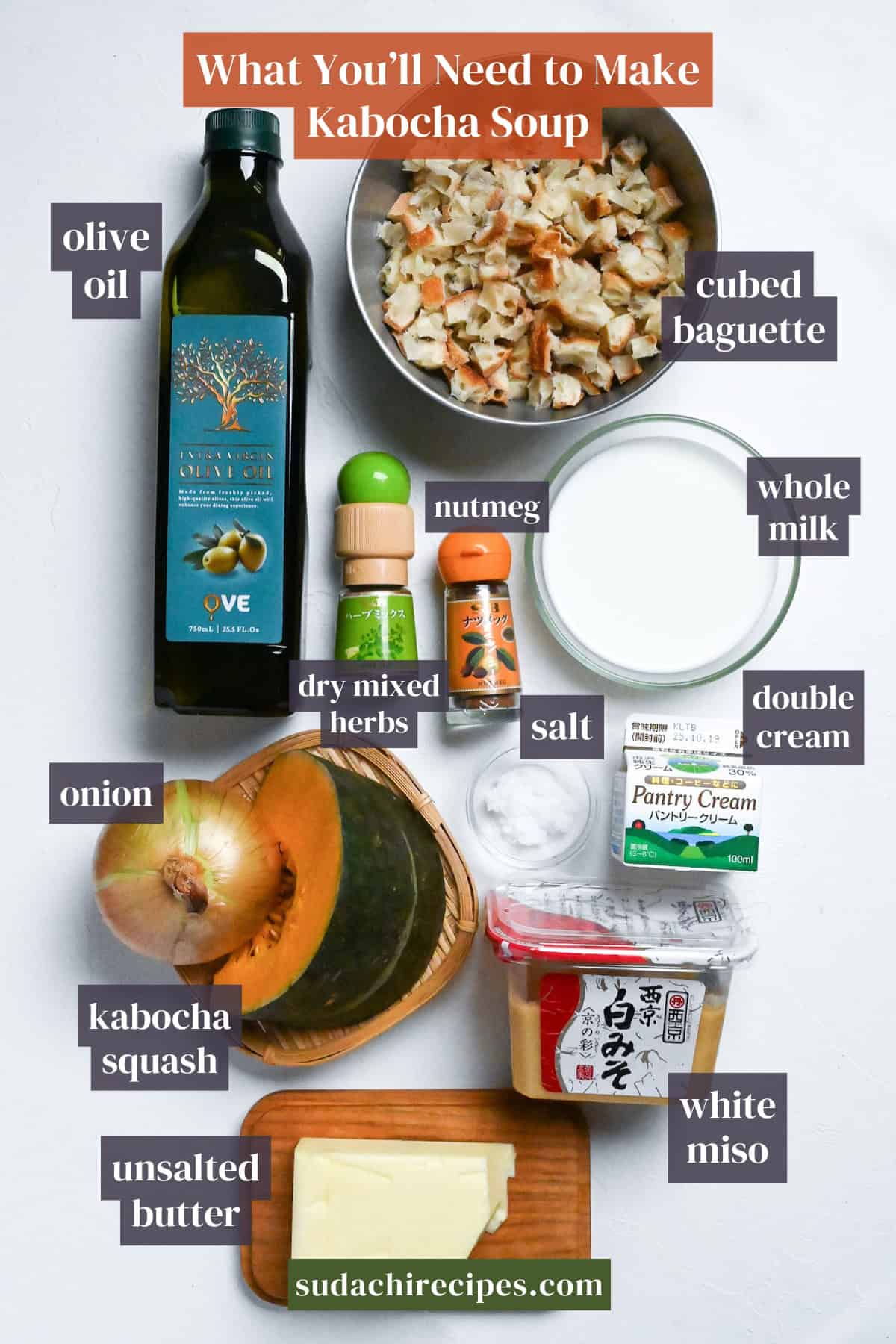
- Kabocha Squash: A naturally sweet, nutty winter squash that purées into a velvety, chestnut-like soup base. You’ll find whole kabocha at Asian groceries and often at fall farmers’ markets. We will discuss alternatives in the next section.
- Onion: This humble ingredient does serious work. It builds the savory backbone that balances kabocha’s sweetness. When you sauté onion slowly in butter until it turns translucent and golden, its natural sugars caramelize and its glutamates (umami compounds) deepen the overall flavor into something restaurant-worthy.
- Milk & Heavy Cream: Whole milk loosens the kabocha purée and makes it sip-smooth.
Substitutions /Variations
- Can’t find kabocha? Buttercup squash is your best bet. Butternut squash works well too, though it’s a bit less sweet and more watery (just simmer it a little longer to concentrate the flavor). Acorn squash is usable but tends to be more fibrous and mild, so roast it first to intensify the sweetness. Skip sugar pumpkins (pie pumpkins). If you’re in Europe, look for “Hokkaido pumpkin” or “Potimarron”.
- Dairy shortcuts: This recipe calls for equal parts milk and heavy cream anyway, you can just use half-and-half from the start if you’re in the U.S.
- Dairy-free options: Swap milk for unsweetened soy milk (adds a subtle nutty flavor) or full-fat canned coconut milk (richer and naturally sweet). For cream, you can try oat cream or coconut cream. Replace butter with olive oil or vegan butter. Plant-based milks can be thinner, so you may need slightly less liquid overall.
- Gluten-free options: The soup is naturally gluten-free as long as you make sure to use gluten-free white miso. You can also use gluten-free baguette for the croutons!
Have trouble finding Japanese ingredients? Check out my ultimate guide to Japanese ingredient substitutes!
How to Make My Kabocha Squash Soup
Before you start: Cube your baguette for croutons and set it aside. Soften or melt the crouton butter so it coats evenly later. Thinly slice your onion.
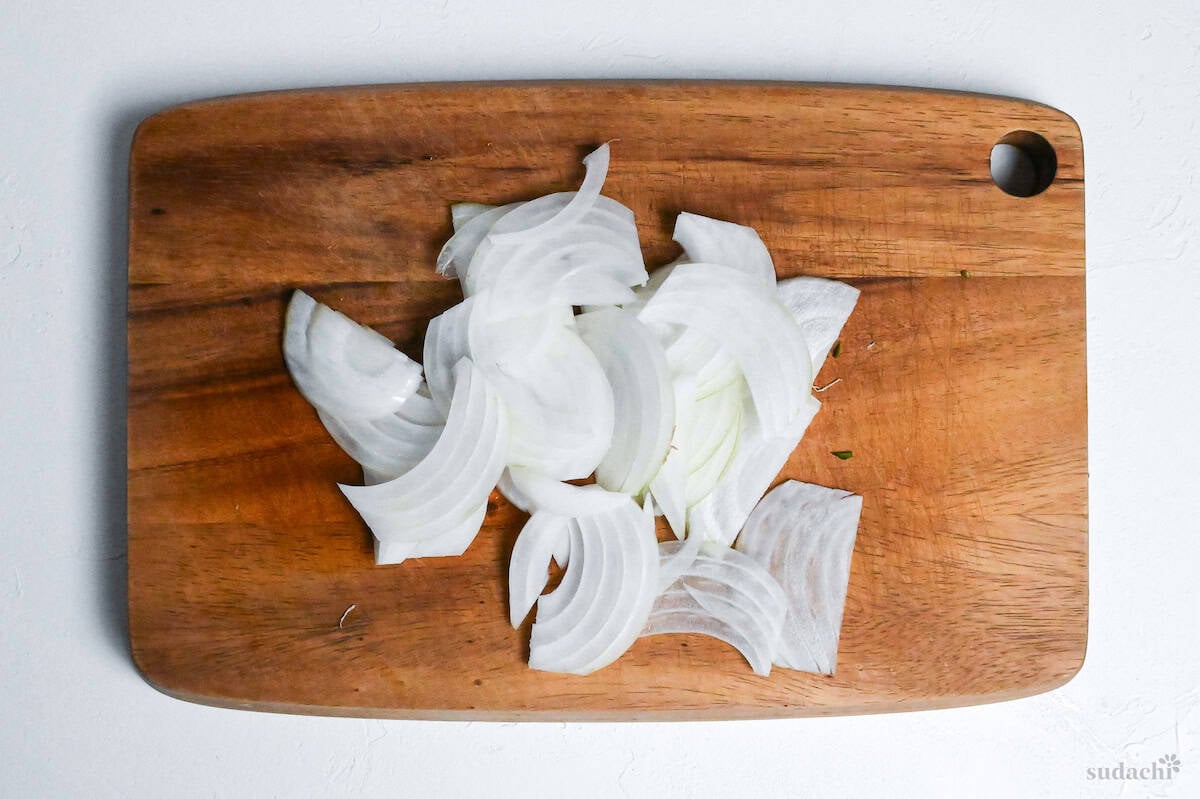
Honestly, I find kabocha naturally sweet enough to skip this step, but if you have time and crave next-level sweetness, roast your squash cubes at 160°F (70°C) in a low oven. The gentle, extended heat converts more starch into sugar. It’s entirely optional, but worth knowing if you’re chasing more sweetness.
i. Use a spoon to scoop out the seeds and pulp from the center of the kabocha.
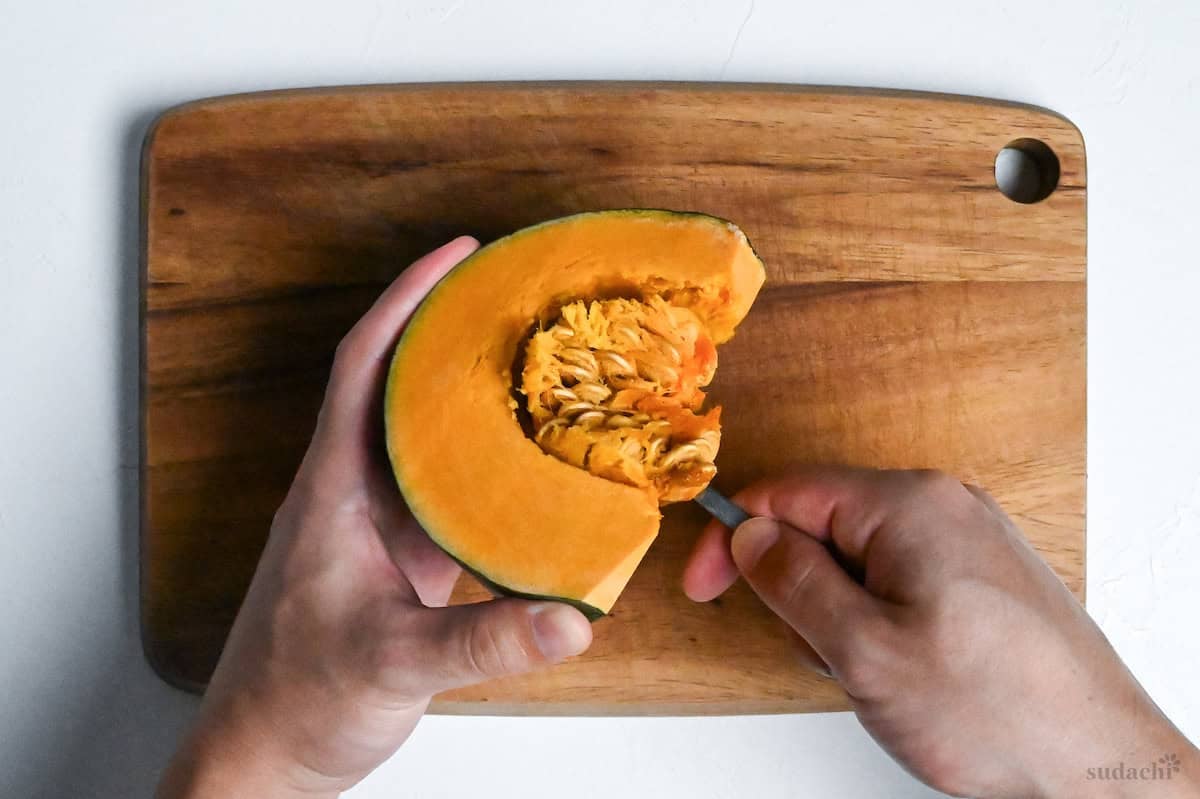
ii. Lay your squash on a stable cutting board and use a sharp knife to shave off the tough green skin in downward strokes.
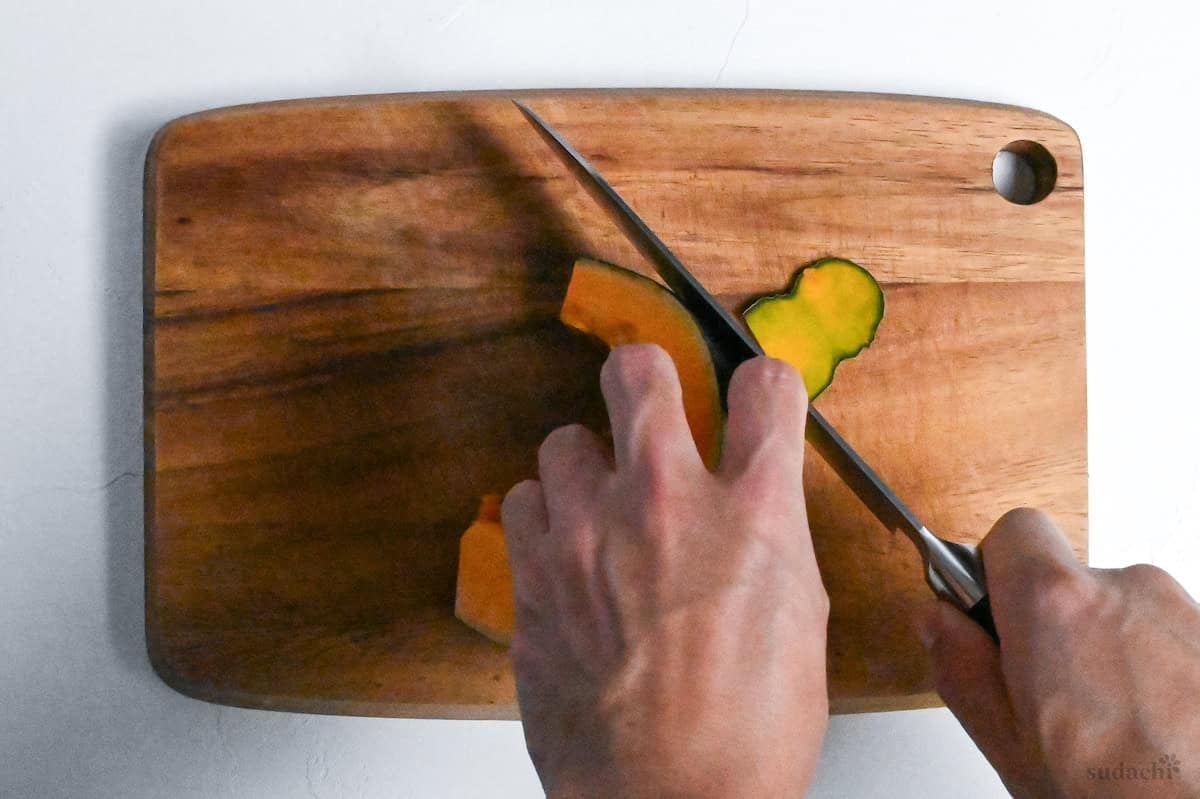
iii. Once peeled, chop the flesh into large, irregular chunks.
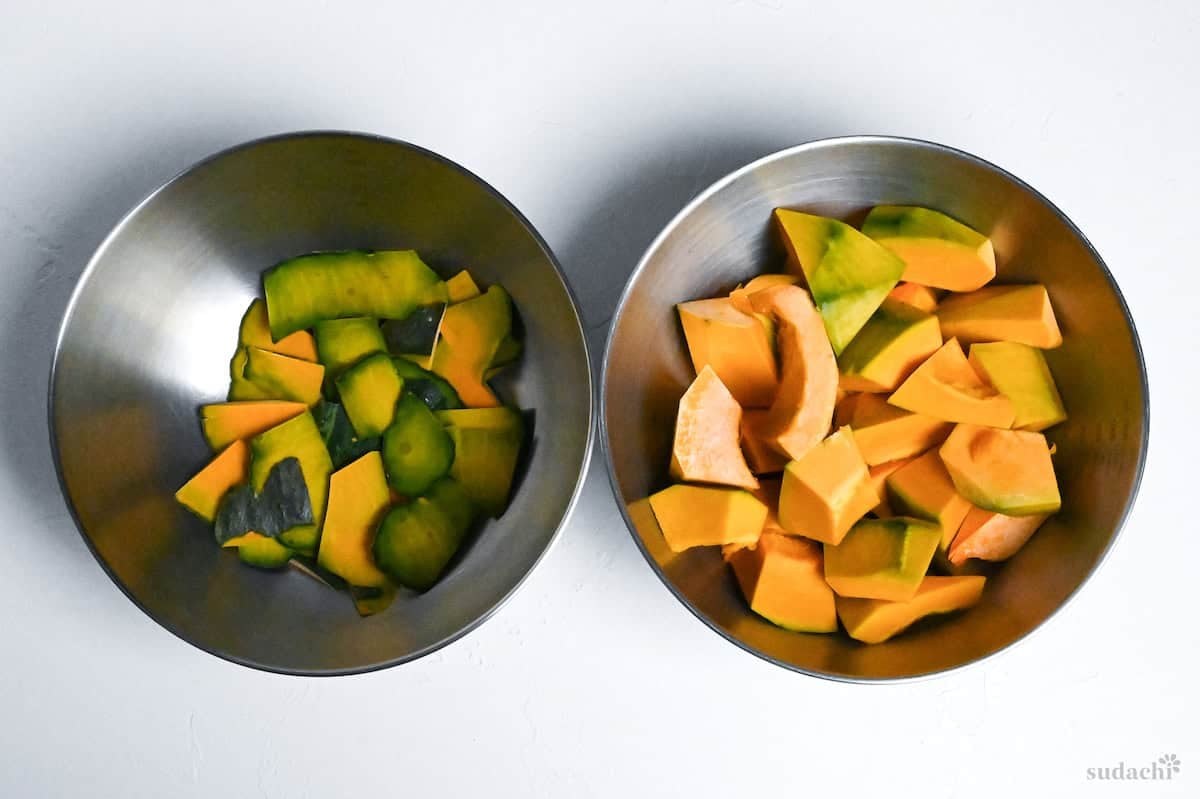
Thin slices cook faster, but one caveat with thin slices is if you’re making a big batch, they pile up and steam unevenly in the pot, creating mushy outer layers and half-raw centers. Think of it as a trade-off: thin = quick and delicate; chunky = patient and luscious. Choose based on your evening.
i. Preheat the oven to 180℃ (356°F). Toss bread cubes with olive oil, salt, dried herb mix, and melted butter. Fold in thin ribbons of tender kabocha peel.
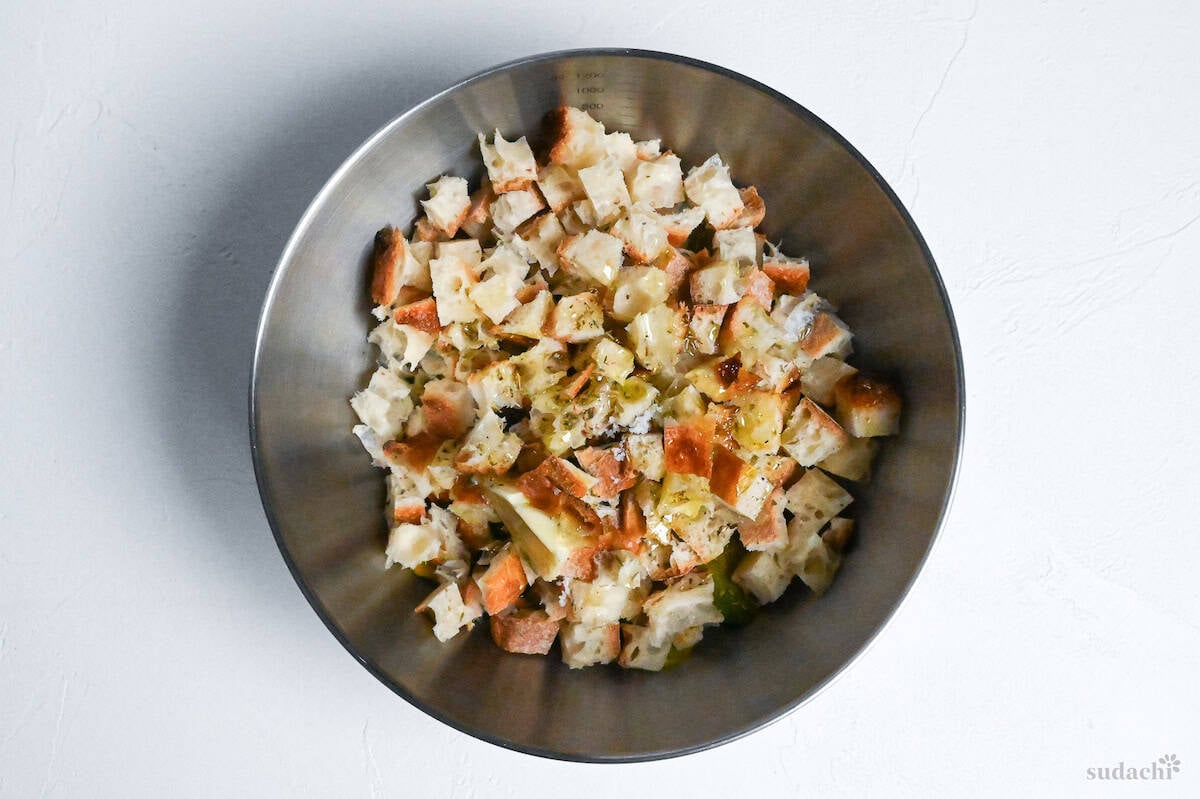
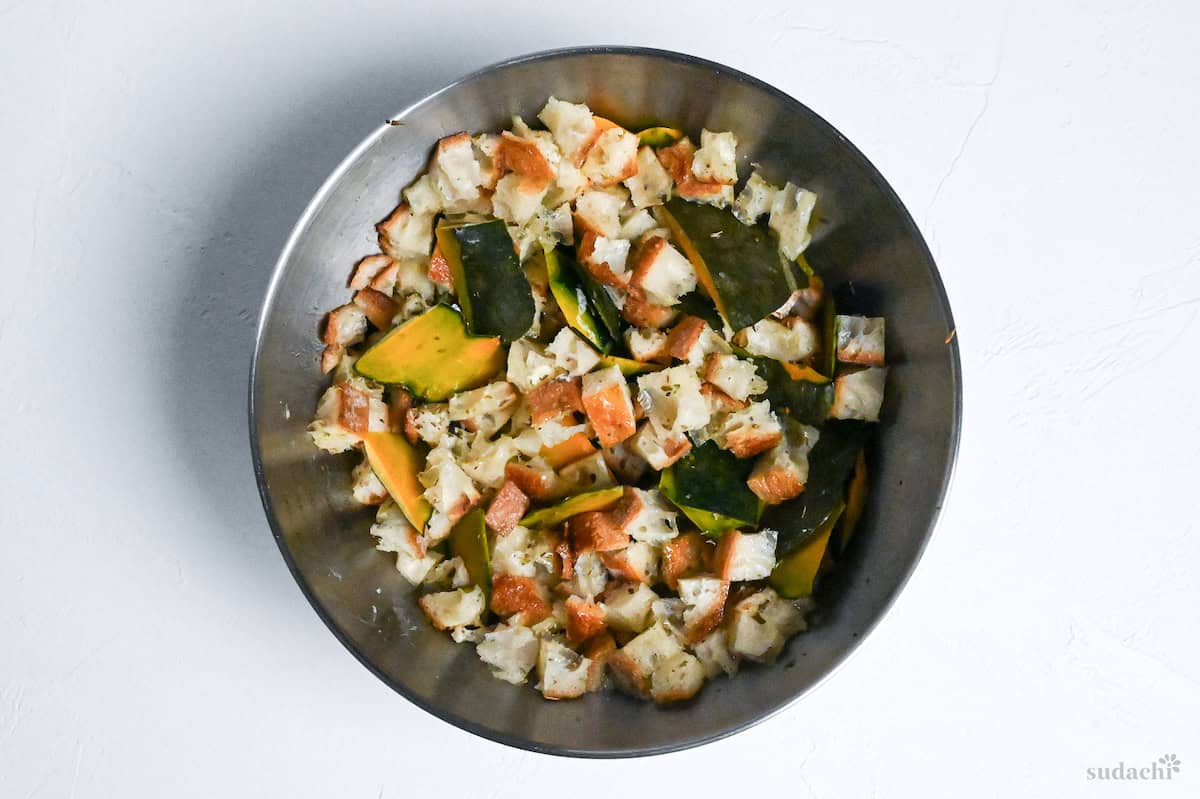
ii. Spread in a single layer and bake on an upper rack for 10 minutes until golden and crisp.

Creamy soups can taste one-note after a few spoonfuls. Velvety, yes, but predictable. The fix? Textural contrast and aromatic punches. Crispy croutons wake up your palate between silky sips, while those roasted kabocha skins add an earthy, almost savory umami note that circles back to the soup’s main ingredient.
There’s also a subtle brain trick at play! When you see recognizable pieces of kabocha floating in the bowl, your mind registers “This is definitely squash soup,” and you perceive the flavor more vividly. Feel free to toss in roasted pumpkin seeds for extra crunch too.
i. While we wait for the oven, melt unsalted butter over medium-low heat. Add the thinly sliced onion and salt. Cook, stirring, until the onion turns translucent and sweet but not browned. Stop just before golden.
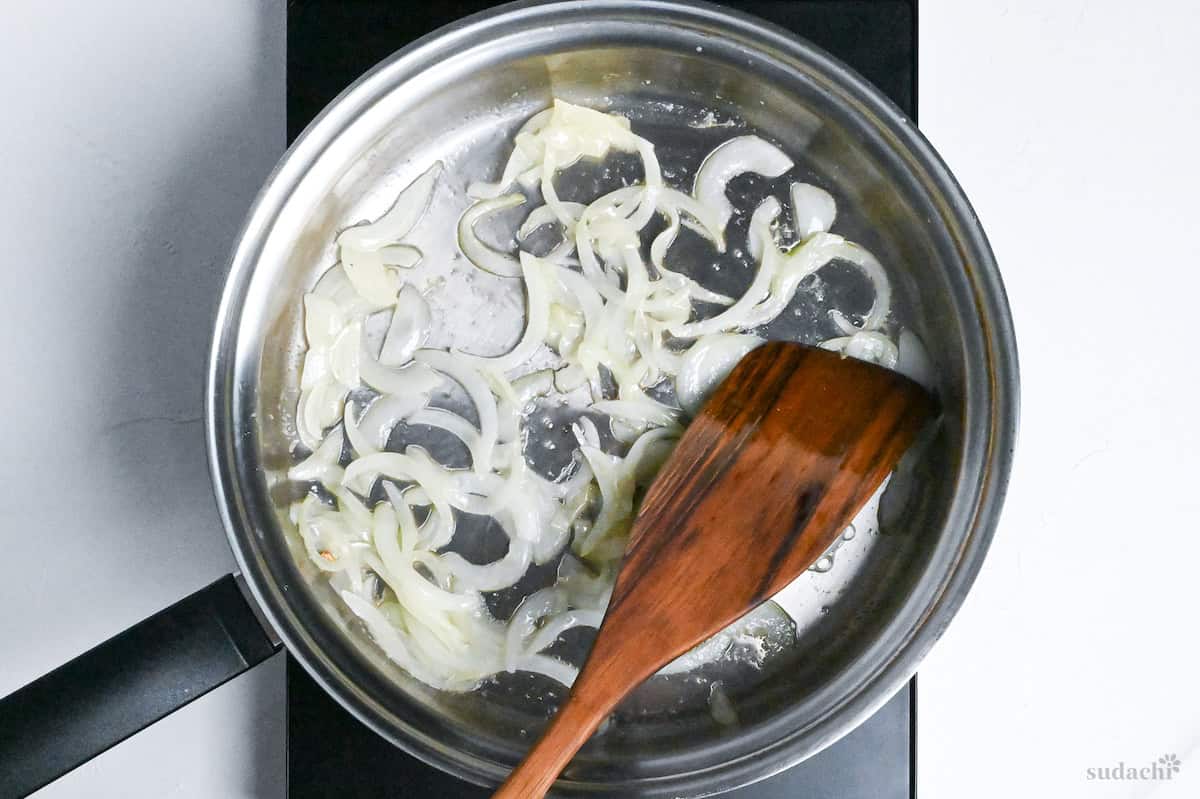
ii. Stir in the kabocha chunks with another pinch of salt. Toss for 1-2 minutes to coat in butter and start softening the surface. Seasoning now helps the squash absorb salt evenly later and prevents flat tasting purée.
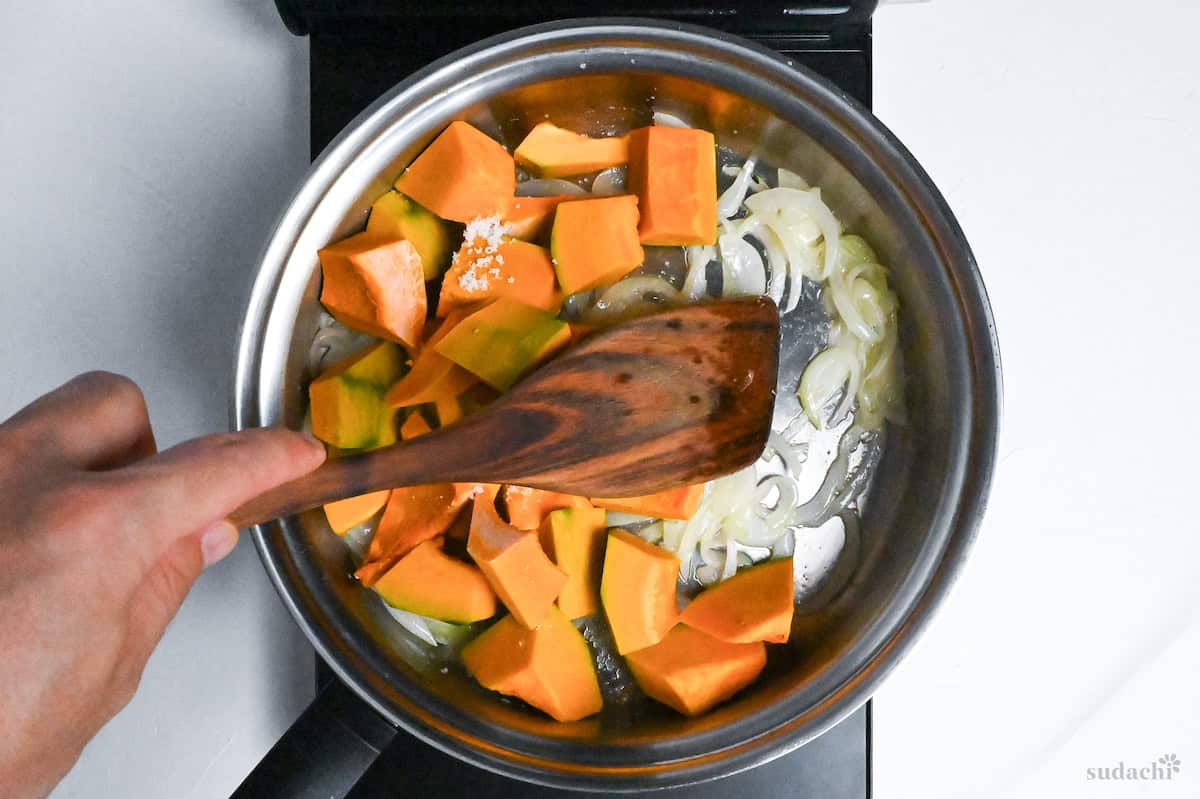
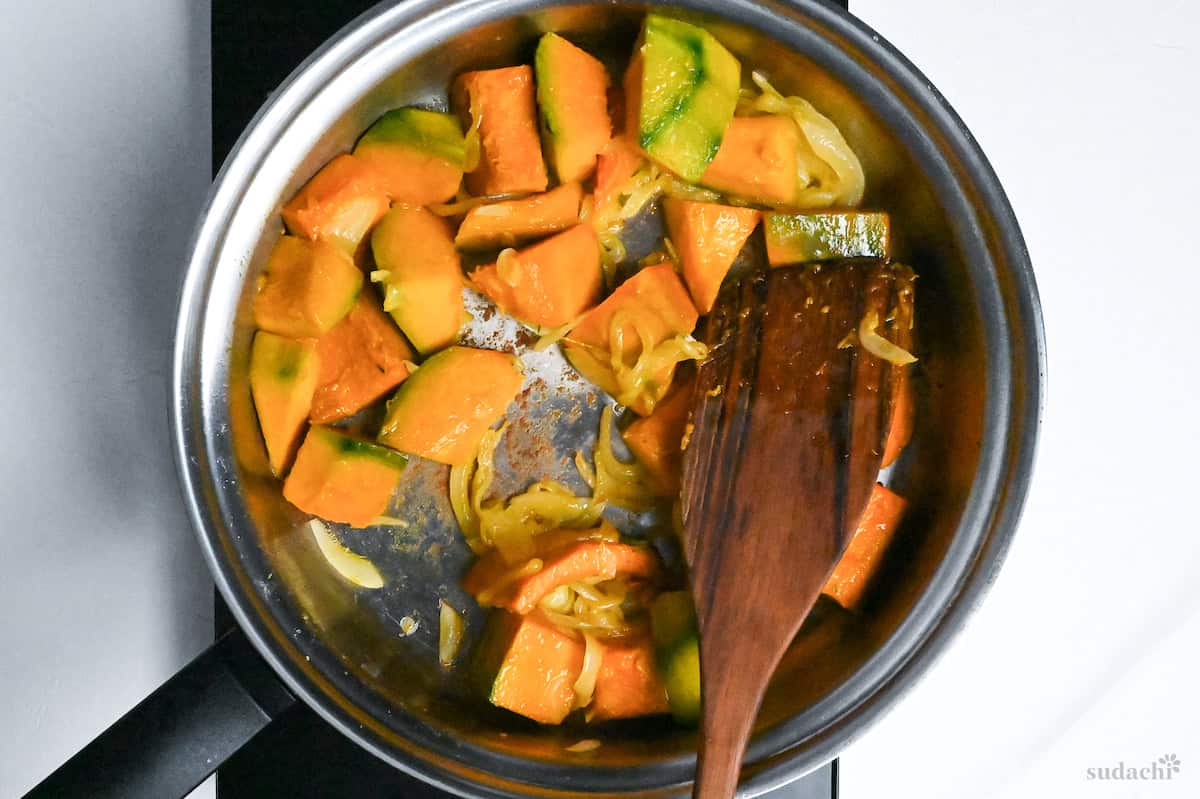
iii. When the edges start to break, add water.
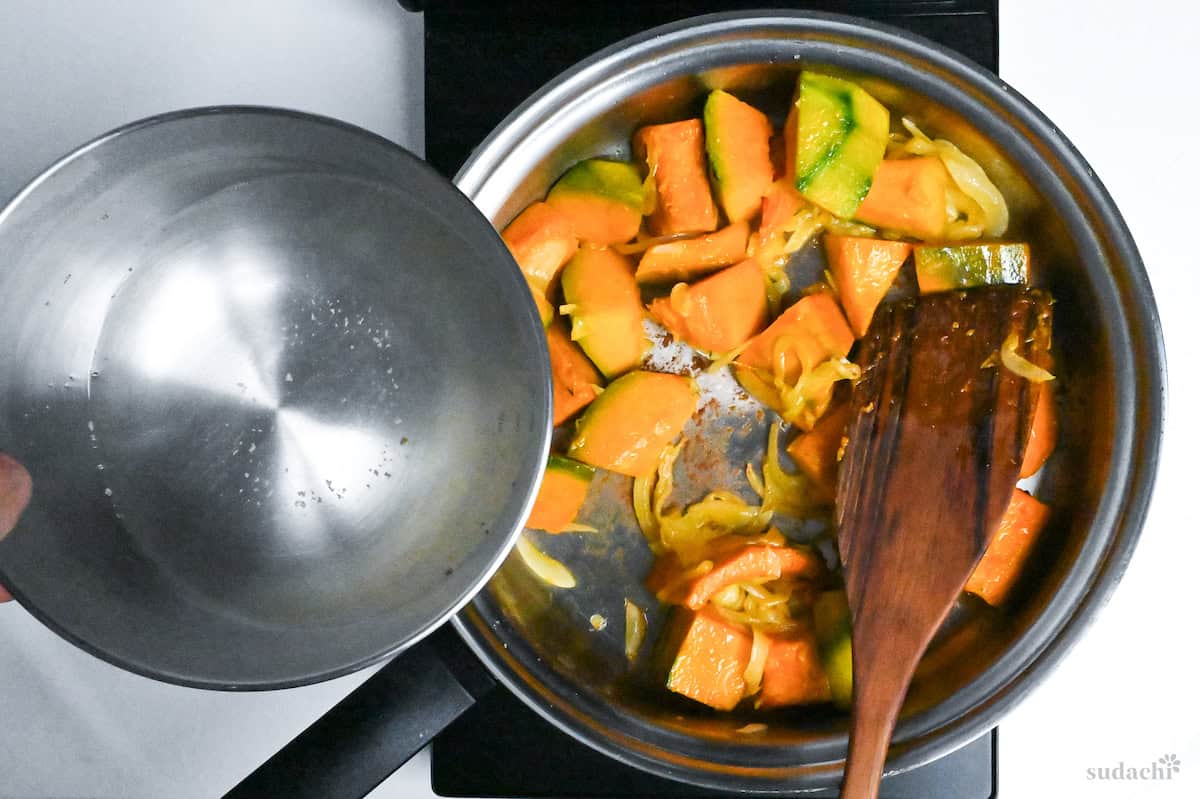
Use kombu dashi stock instead of plain water to amplify the umami!
iv. Cover and simmer on low for 10-15 minutes until the pumpkin crushes easily with a spoon. Keep the bubbling gentle to preserve color and a fresh, sweet aroma.
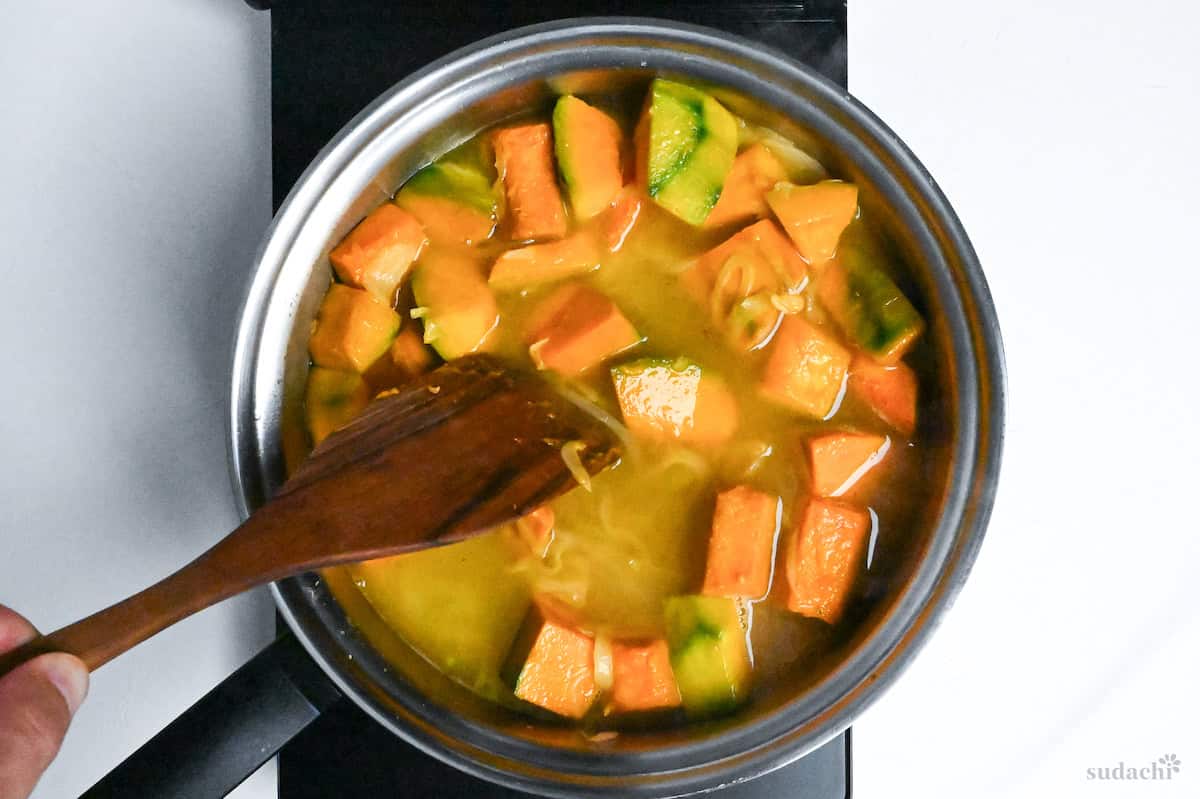
v. If liquid reduces too fast, add a splash of hot water to maintain a shallow “just-covered” level.
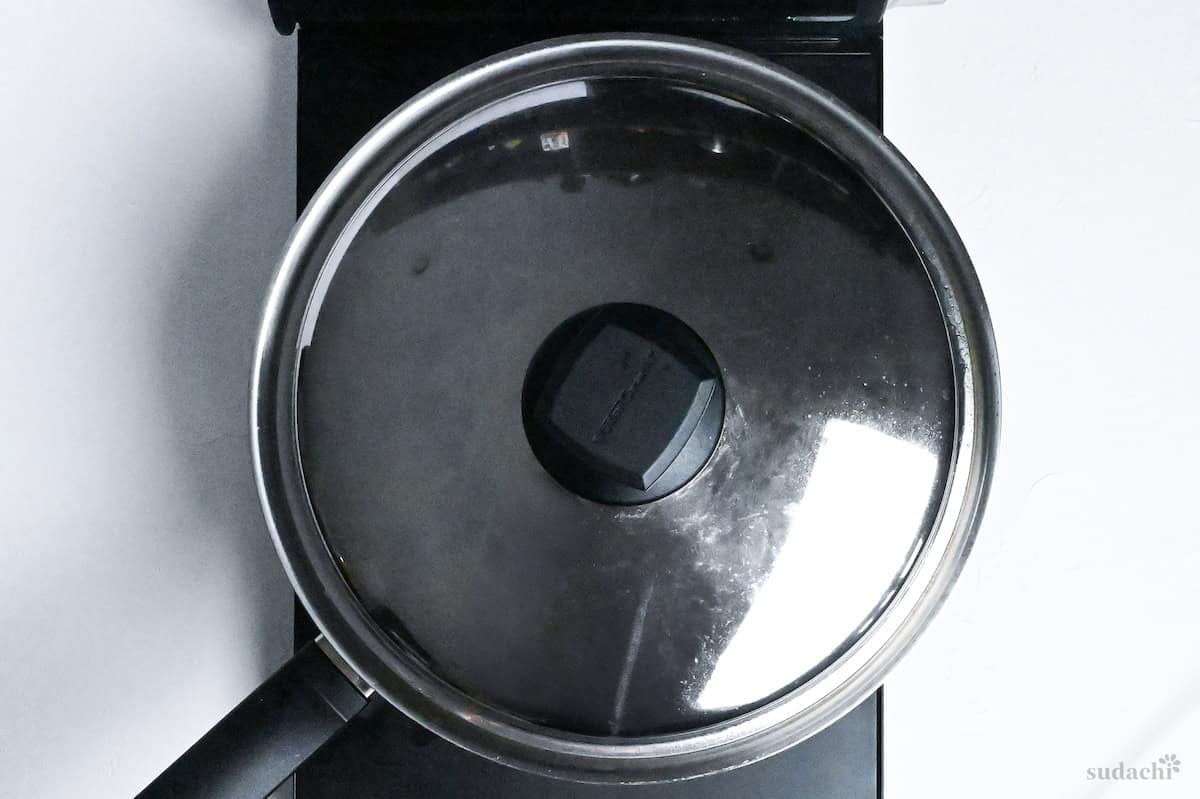
i. Take the pot off heat and blend with a blender (or immersion blender), starting low and moving to high, sweeping the head across the pot to catch fibers.
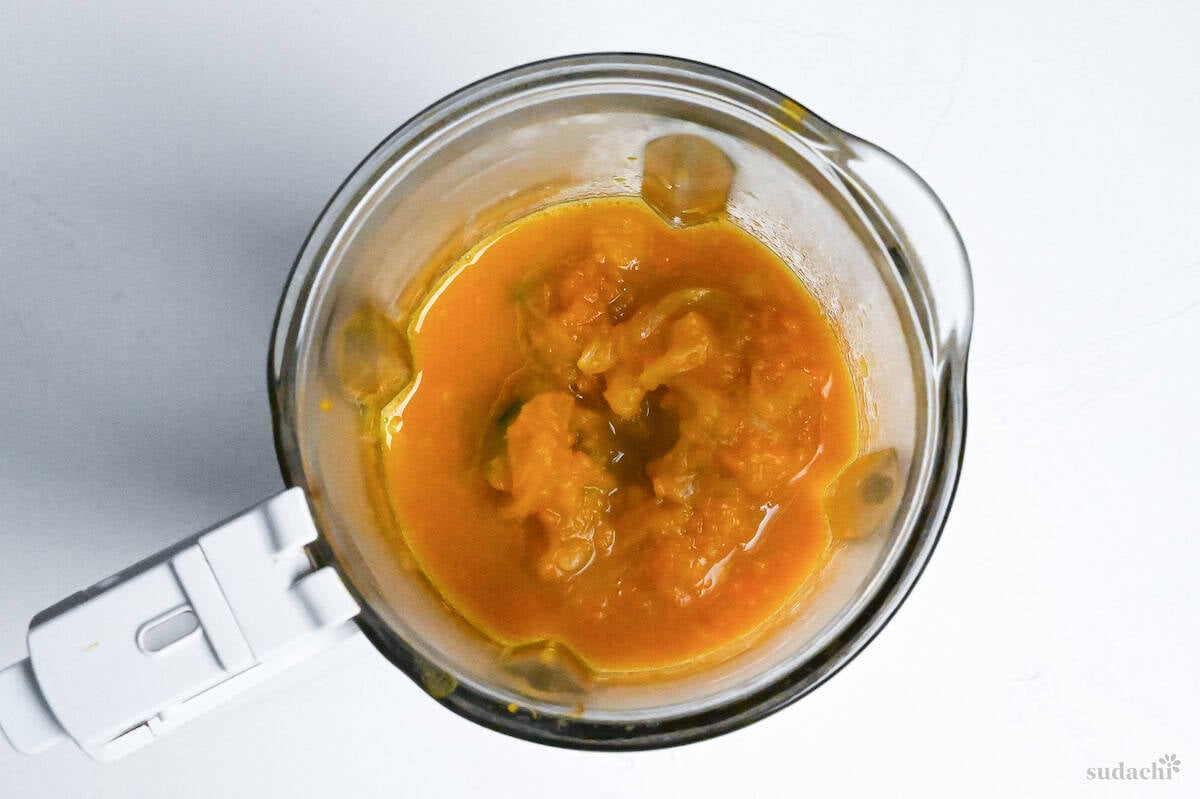
ii. When smooth, add cold unsalted butter and blend 20-30 seconds more to micro-emulsify for gloss and body.
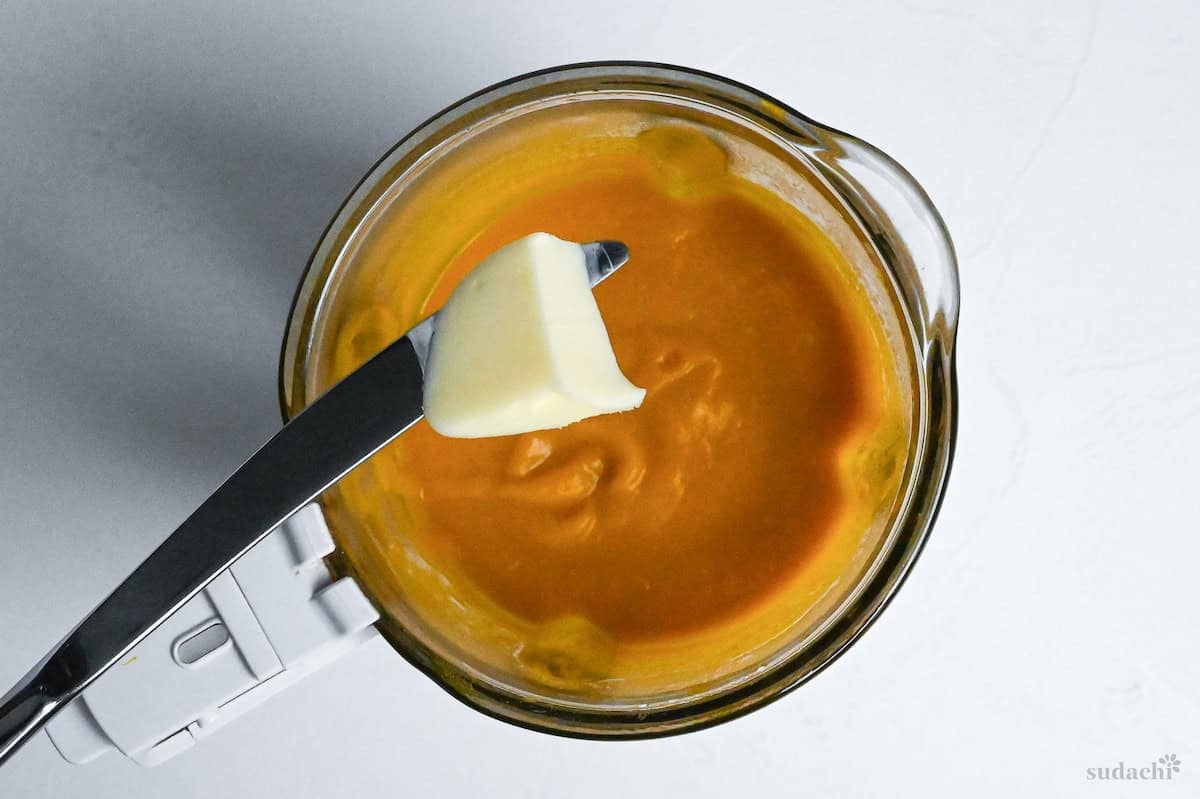
Blending from low to high reduces pockets of unblended pulp, and adding butter during blending helps create a stable emulsion for a silkier mouthfeel. Pressing the soup through a strainer after blending yields a restaurant-smooth finish.
i. If you want the kind of texture that makes guests ask “Did you really make this at home?”, pour your blended soup through a fine-mesh strainer or chinois into a clean pot.
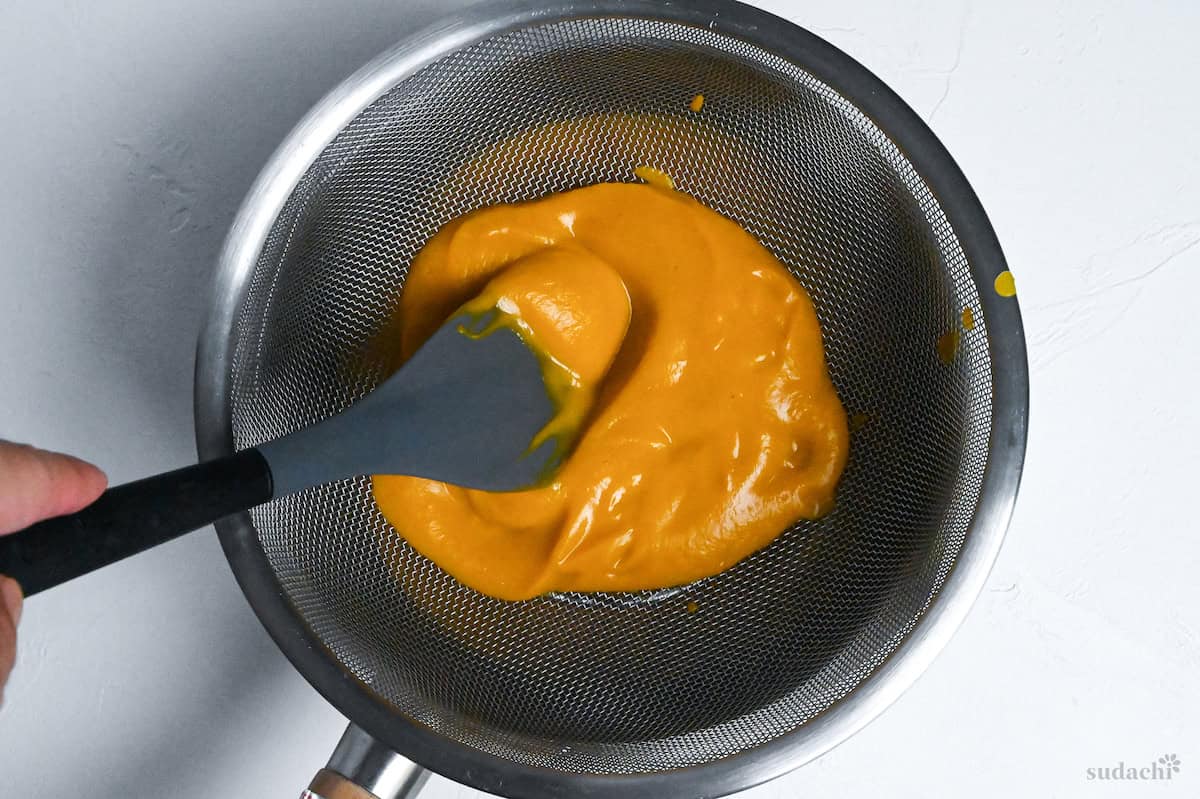
ii. Use the back of a ladle or spoon to press the puree through, leaving behind any lingering fibers or skin fragments. Yes, it’s an extra dish to wash, but the payoff is soup so smooth it coats a spoon in a glossy, unbroken ribbon.
i. Return the soup to a clean pot and stir in heavy cream and milk (you can use half and half if it’s available). Warm gently over low heat until steamy and slightly thickened, but do not boil.
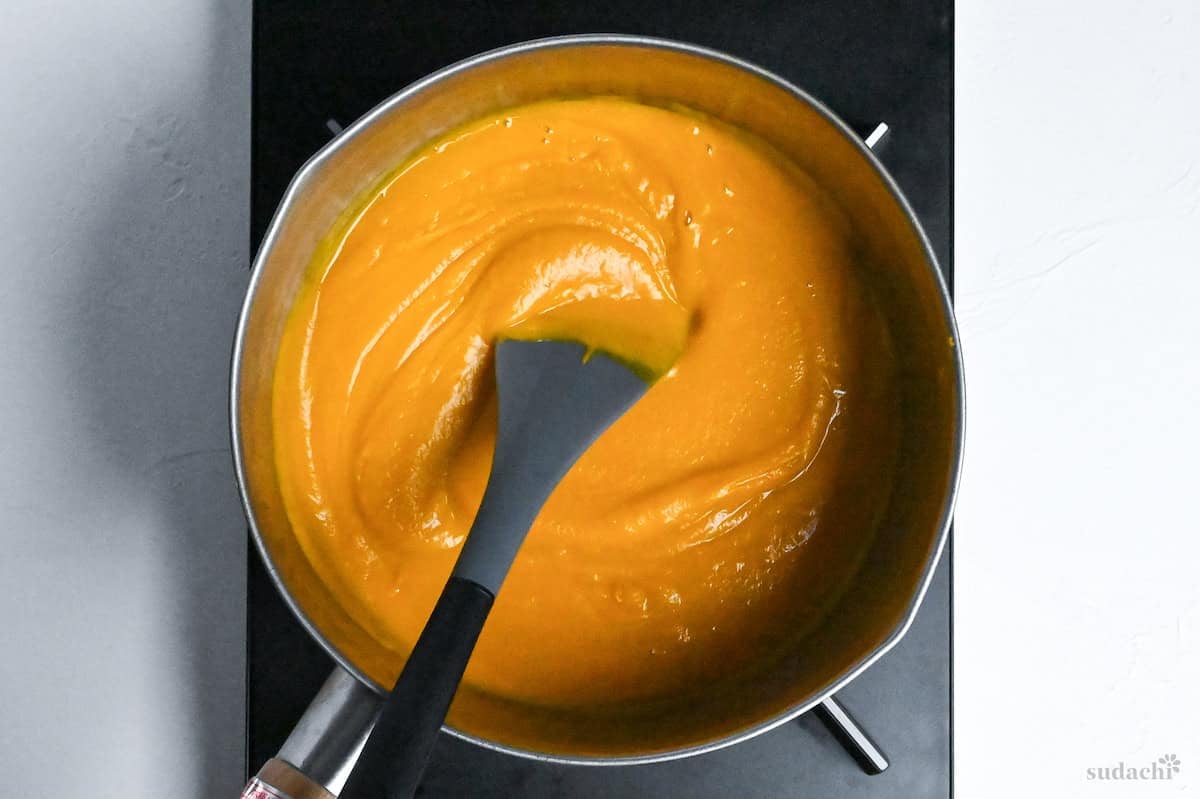
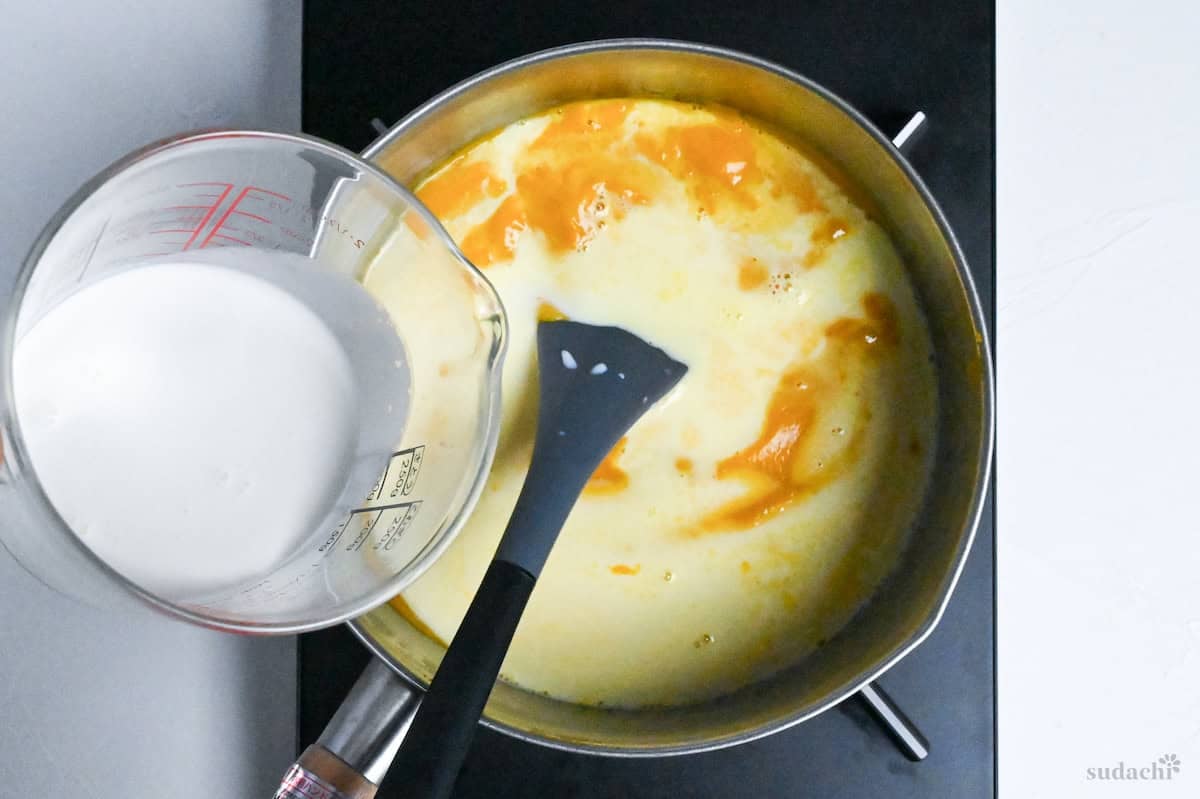
ii. Add another pinch of salt and a sprinkle nutmeg. Set the heat to low and let the soup barely simmer, about 3-5 minutes. Stir occasionally to prevent a skin from forming.

Once dairy enters the pot, high heat is your enemy. Boiling causes the milk proteins to curdle and the cream to separate into greasy puddles. Keep it at a lazy simmer.
iii. Turn off the heat and dissolve white miso. Make sure to taste test at this point!
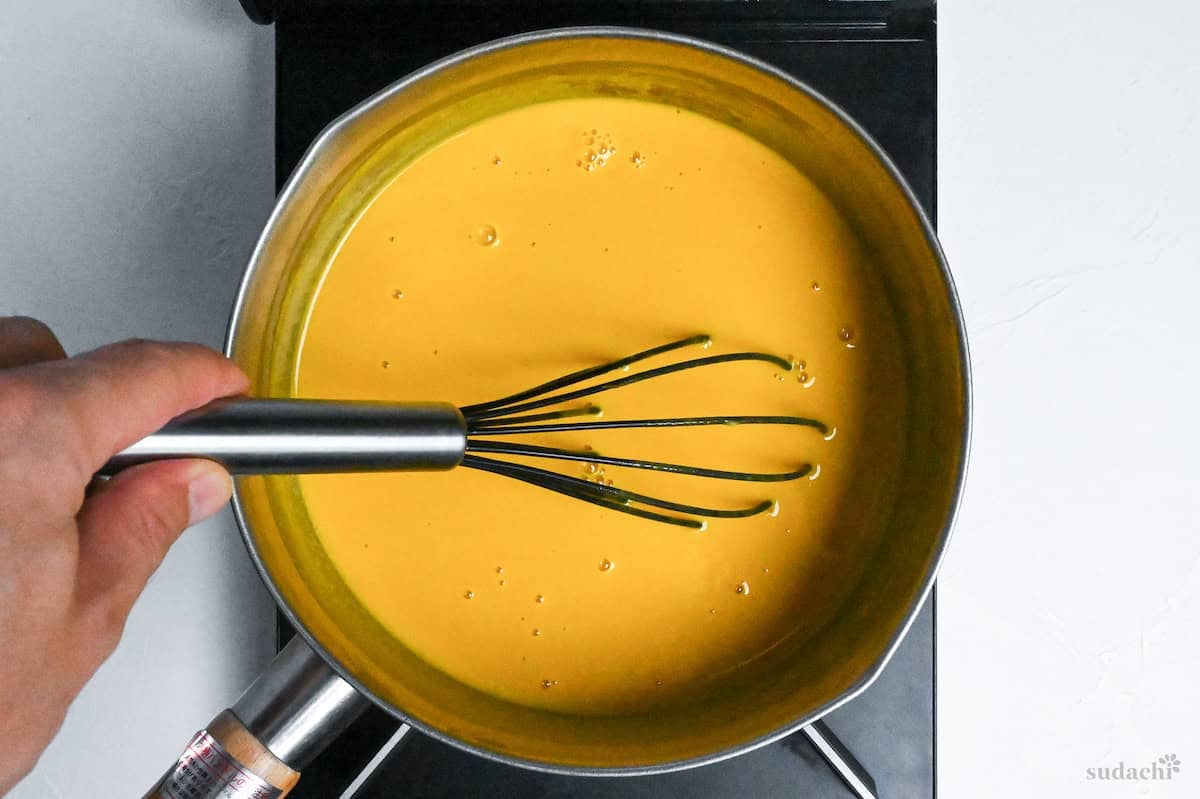
Every kabocha varies in sweetness, so grab a spoon and taste. If the soup feels flat or one-dimensional, add salt one pinch at a time. Counterintuitively, too little salt mutes the squash flavor instead of letting it shine. Went overboard? Rescue it by whisking in milk a tablespoon at a time until balanced. Keep adjusting until the kabocha’s natural sweetness suddenly pops on your tongue.
i. Ladle the hot soup into warmed bowls. Crack white pepper over the surface, scatter a handful of those kabocha-skin croutons on top, and finish with a pinch of chopped fresh parsley for a pop of green against the orange.


Essential Tips & Tricks
- Blend low to high for silky texture and finish with butter to stabilize the emulsion and prevent graininess.
- Strain for next-level smoothness.
- Use clear visual and sensory cues to guide timing more reliably than minutes (translucent onions, fork-tender pumpkin, gentle steam).
- Don’t skip the tasting step before serving. Kabocha sweetness varies wildly by squash, so taste and adjust salt pinch by pinch. Too little salt actually flattens the squash flavor instead of boosting it.
- Keep the heat low once dairy goes in to prevent splitting, curdling or scorched milk flavor.
With these simple tips in mind, you’re set for success every time you make kabocha soup.
Storage & Meal Prep
Fridge: Store in an airtight glass or BPA-free container for 2-3 days. Let the soup cool completely before sealing to prevent condensation and spoilage.
Freezer: Freeze the concentrated base (before adding milk and cream) for best results, up to 3-4 weeks.
Meal Prep: Make the soup base (through the blending step) up to 2 days ahead and refrigerate. Add dairy and final seasonings just before serving to keep the texture silky. Croutons stay crispy for 3 days in an airtight container, kabocha skins should be stored separately in the fridge for 1-2 days.
Reheating: Transfer chilled or thawed soup to a pot and warm over low heat, stirring frequently to prevent scorching.
What to Serve With This Recipe
Kabocha Soup Q&A
You likely added too much milk, cream, or didn’t use enough salt.
Once you add dairy, keep the heat low and stir frequently. Milk boils over easily and burns quickly on high heat. Use a heavy-bottomed pot and never fill it more than three-quarters full.
Incomplete blending or straining leaves squash fibers and onion bits behind. Blend from low to high until fully smooth and pass through a fine mesh sieve or chinois.
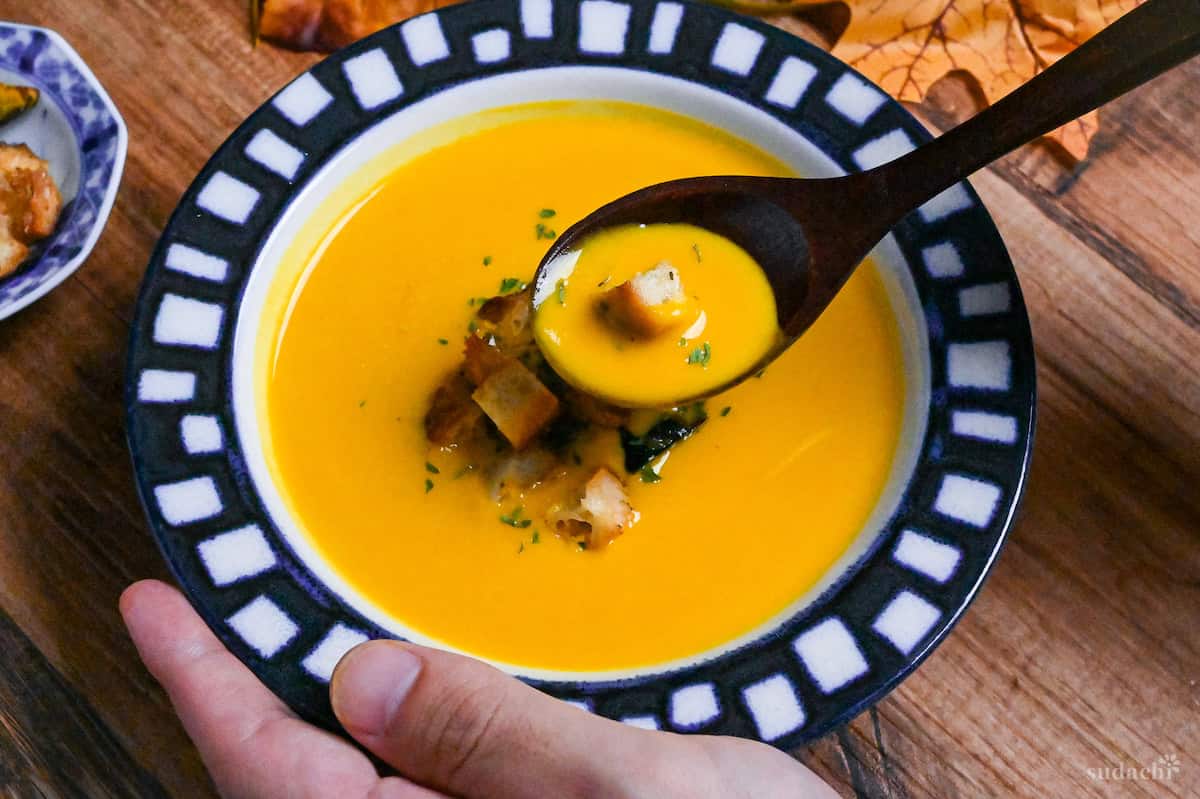
More Japanese Soup Recipes
From clear broths to hearty miso bowls, learn about all the types of Japanese soup you can make at home!
Did You Try This Recipe?
I would love to hear your thoughts!
💬 Leave a review and ⭐️ rating in the comments below. 📷 I also love to see your photos – submit them here!

Easy Kabocha Squash Soup
Ingredients
- ½ onion yellow or white
- 450 g kabocha squash substitute: buttercup, butternut, or Hokkaido pumpkin, avoid pie pumpkins
- 20 g unsalted butter for sautéing, use olive oil or vegan butter for dairy-free
- ¾ tsp salt ¼ tsp × 3, divided
- 300 ml water or kombu dashi for added umami
- 10 g unsalted butter for blending
- 150 ml heavy cream or half-and-half instead of separate milk + cream
- 150 ml whole milk or half-and-half
- 1 pinch nutmeg powder
- ½ tsp white miso paste
- ground white pepper to taste
- dried parsley to taste
Croutons & kabocha skin topping
- 100 g baguette cubed, gluten-free baguette also works
- 1 tbsp olive oil
- 1 tsp dry mixed herbs Italian seasoning or herbs de Provence
- ⅛ tsp salt
- 1 tbsp unsalted butter melted or very soft
My recommended brands of ingredients and seasonings can be found in my Japanese pantry guide.
Can’t find certain Japanese ingredients? See my substitution guide here.
Instructions
- Before you start, preheat your oven to 180 °C (356 °F) and thinly slice ½ onion.

- Scoop out the seeds and pulp from the center of 450 g kabocha squash.

- Place the flat side down on a stable cutting board and use a sharp knife to cut off the skin in downward strokes. Save the pieces of skin for later.

- Cut the rest of the kabocha into large chunks and set aside for later.

- Cut 100 g baguette into bitesize cubes and place them in a mixing bowl. Add 1 tbsp olive oil , 1 tsp dry mixed herbs, ⅛ tsp salt and 1 tbsp unsalted butter (melted). Toss until evenly coated, then add the kabocha skin and mix again.

- Spread the baguette and kabocha skin in a single layer on a baking sheet and bake at 180 °C (356 °F) on the top shelf for 10 minutes.

- Heat a pot on medium low and add 20 g unsalted butter. Once melted, add the sliced onion and ¼ tsp salt. Fry gently until translucent.

- Add the kabocha and another ¼ tsp salt, and cook until the edges start to soften.

- Pour 300 ml water into the pot and cover. Cover and simmer on low for 10-15 minutes or until the kabocha is soft enough to crush with a spoon. Check occasionally and add a splash of water if needed.

- Use a heatproof blender or immersion blender to blitz until smooth. Add 10 g unsalted butter and blitz for another 20-30 seconds.

- For an extra smooth result, pour through a mesh sieve over a clean pot.

- Place the pot back on the stovetop and add 150 ml heavy cream and 150 ml whole milk. Add ¼ tsp salt and 1 pinch nutmeg powder. Heat on low until it reaches a low simmer. Stir occasionally to prevent a skin forming.

- Turn off the heat and whisk in ½ tsp white miso paste.

- Pour into warmed serving bowls and place the croutons and kabocha skin slices in the center. Sprinkle with ground white pepper and dried parsley to taste. Enjoy!




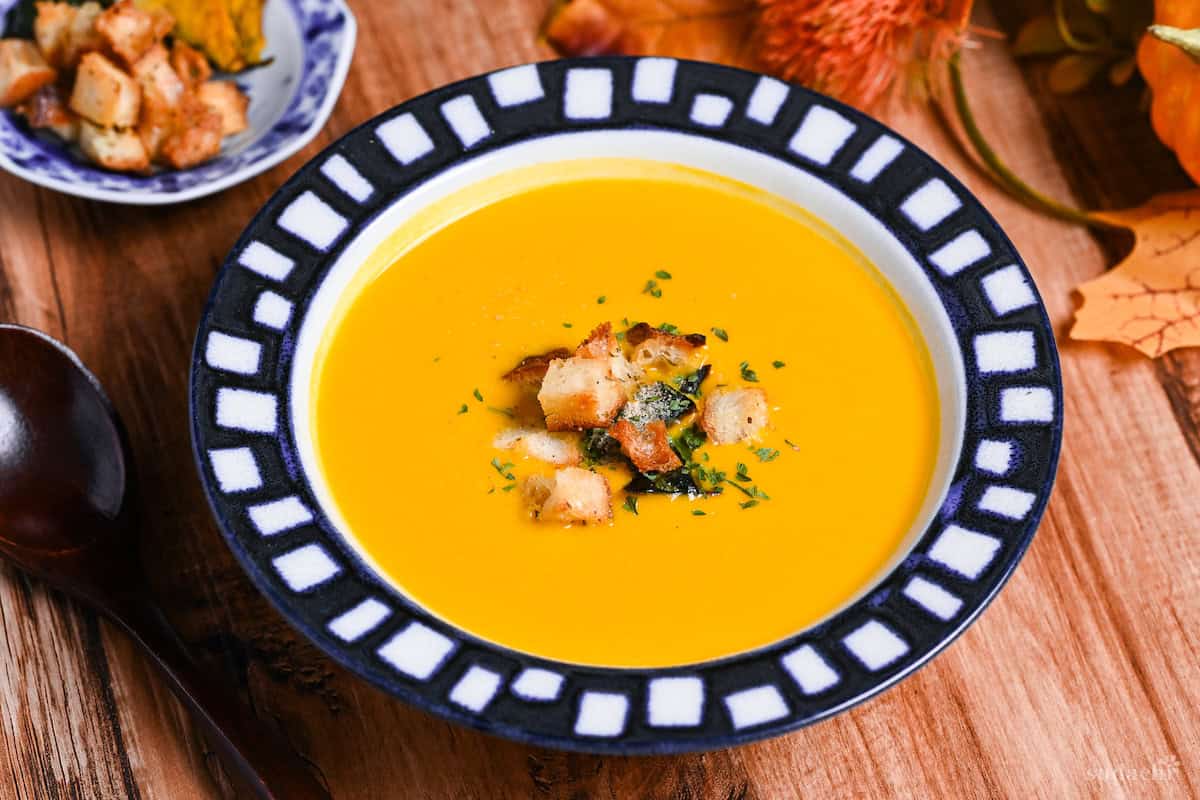
Leave a rating and a comment